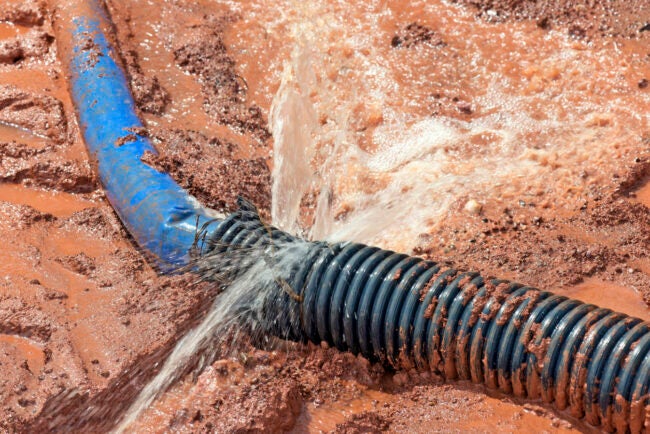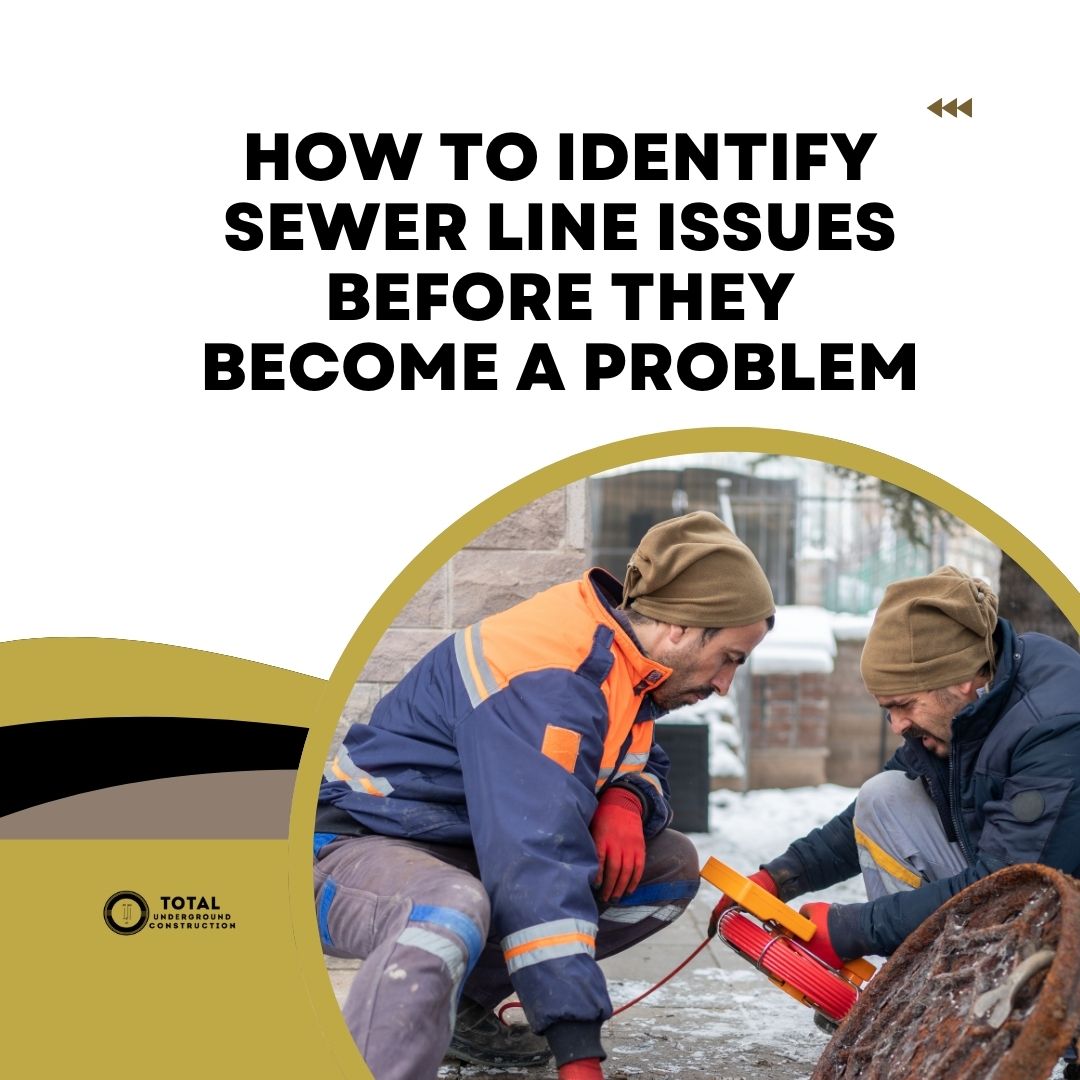Dealing with occasional clogs in your toilet, bathroom, or sink drains can be frustrating. However, it does not compare to the nightmare a sewer line blockage unleashes. It might be time to investigate if there is clogging in your main sewer if you are experiencing funky odor wafting through your home, slow drains, or sewer water backing.
At Total UC, plumbing is our lifeblood. We help you know the causes and identify the signs of a blocked sewer to expedite mitigation strategies.
What Causes Main Sewer Blockage?

- Accumulations of Fats, Oils, or Grease
Pouring fats, oils, and grease (FOG) down the drain may seem harmless, but they can wreak havoc on your sewer system when they accumulate. FOG cools and solidifies in the main sewer pipe, sticking to the inner walls.
Over time, these sticky deposits grow larger, constricting wastewater flow. As more FOG accumulates, it traps other debris like food particles and hair, forming stubborn blockages that can lead to sewage backups.
- Tree Root Intrusion
Invasive tree roots are a leading cause of sewer line blockages. When trees or shrubs grow near the main underground sewer line, their roots naturally seek out sources of water and nutrients. These roots take advantage of the warmth and moisture found in sewer lines.
In their quest for sustenance, tree roots infiltrate small cracks or loose joints in the sewer line, extending their feelers to thrive on the nutrients present in the sewage. They continue to grow and expand, creating obstructions that impede wastewater flow. Over time, debris accumulates on the roots, worsening the blockage and breaking the pipe.
- Poor Plumbing Connections
Faulty plumbing connections in the main sewer line can cause blockages in the connected drainage systems. When inexperienced or unlicensed plumbers install your sewer system improperly or the main line pipe deteriorates over time, they can create gaps, leaks, or misaligned joints.
These errors cause debris, such as dirt, hair, and other particles, to accumulate and form blockages. Additionally, the uneven surfaces created by poor plumbing connections can cause wastewater to flow unevenly, leading to the buildup of sediment and solid materials.
- Flushing Wet Wipes
Flushing wet wipes down the toilet may seem convenient, but they are notorious sewer line blockage culprits. Unlike toilet paper, the wet wipe design is more durable.
Even the flushable options do not readily dissolve in wastewater. Instead, they get stuck in pipe bends and cling to grease buildup, hindering sewer water flow. Eventually, the growing blockage causes sewage backups, pipe damage, and costly repairs.
- Old or Weak Sewer System
Worn-out and fragile sewer systems contribute to blockages in several ways. An old or weak sewer line is vulnerable to cracks, misalignments, or collapses, increasing the risk of debris, sediments, and tree root infiltration.
The worn components of an old sewer line are also more susceptible to clogging. Additionally, older sewer systems may have smaller pipe diameters, reducing their capacity to handle higher wastewater volumes and leading to blockages.
7 Signs of Clogged Sewer Line
- Multiple Drain Back Up
Experiencing multiple drain backups throughout your home indicates a potential main sewer line blockage. The state and condition of the main sewer lines affect the connected drainage system. Consequently, when all your drains have slow drainage or backups simultaneously, the main sewer line could be the cause. The blockage from the main sewer line impedes wastewater flow from various fixtures.
- Foul Odor from Tubs, Sinks & Drains
When the sewer line is clogged, sewage and wastewater cannot flow freely, causing them to back up into your plumbing system. The backup produces a foul odor permeating the drains and fixtures connected to the main sewer line. Unpleasant smells can also come from the stagnant water and trapped debris in your tubs, sinks, and drains.
- Flooded Backyard
Plumbers bury sewer lines several feet underground to shield the pipes from physical impact, extreme weather conditions, and potential interference from human activities.
When the sewer system develops leaks from clogs, wear and tear, or tree root interference, your backyard slowly begins to saturate with wastewater. Eventually, the whole place will flood as sewage or foul-smelling water from toilets, sinks, showers, and other drains overflow from cleanouts or drain openings.
- Babbling Sounds in Drains
When there is a partial obstruction in the drain or sewer line, water tries to flow past it, causing turbulence and creating babbling or gurgling sounds. These sounds occur as air and water mix, trying to find a way around the blockage.
The babbling sounds may be heard in various fixtures, such as sinks, toilets, or showers, indicating that the clog is affecting the drainage system as a whole.
- Slow Drains
A blockage in the main sewer line restricts wastewater flow from multiple fixtures connected to it. You may notice water takes longer to drain from sinks, showers, tubs, and toilets. Therefore, if you consistently encounter slow drains in different areas of your home, the main sewer line could be a potential problem.
- Blocked Toilet
If your toilet persistently blocks despite all your successful unclogging attempts to unclog, suggest a more significant issue within the main sewer line. A blockage in the main sewer line can prevent proper drainage from the toilet, leading to frequent clogs, slow flushing, or even complete backups.
A main sewer line blockage will also affect other areas of your plumbing system. Therefore, you can look for other drainage flow issues in the home.
- Insect and Rodent Infestation
Rats and insects like cockroaches, ants, and drain flies live in sewers. A tiny crack in your main sewer line will attract and permit them entry into your home for shelter and sustenance.
The stagnant water and organic matter accumulating in the pipes also attract pests seeking moisture and a food source. If you notice an unusual increase in insect or rodent activity in your home, it is essential to investigate the possibility of a blocked main sewer line.
Home Remedies to Unclog Main Sewer
Although there are several home remedies to fix sewer lines temporarily, they are not foolproof solutions. They can also worsen the already existing condition or create new ones. Therefore, proceed with caution.
Plumbing Snake
You can clear a minor main sewer line clog using a plumbing snake. A plumbing snake, also known as a drain auger or drain snake, is a flexible tool consisting of a long, coiled wire cable with a handle at one end and a corkscrew-like tip at the other end. It works by slowly inserting the snake into a drain or pipe with a clog until it meets the obstruction. Rotate the handle to engage or grab the blockage.
As the snake rotates, it pressurizes the clog shuttering it or hooking on to it. The corkscrew tip dislodges or snags the debris, pulling it out or pushing it further down the pipe. Retract the snake after loosening the blockage bringing the clog with it. Removing the clog restores normal sewer flow.
It is important to note that while a plumbing snake can effectively clear minor clogs, it is not a suitable method for unclogging main sewer lines. Here are some limitations of a plumbing snake:
- Insufficient Reach
Most plumbing snakes available for home use cannot reach deep into the main sewer line. The blockage might be located far beyond the reach of a typical plumbing snake, making it ineffective.
- Lack of Visibility
It is challenging to identify potential underlying issues or determine the most appropriate course of action when using a plumbing snake because you cannot visually assess the extent of the blockage.
- Potential for Serious Injury
The coiled wire inside the plumbing snake harnesses energy while in use. Improper use can cause a recoil back at the user at higher speeds, resulting in severe injuries. Your risk of potential injury increases when using powerful electric plumbing snakes.
- Potential for Damage
A plumbing snake can puncture or scratch your main sewer line if used with excessive force or improperly, resulting in leaks, further blockages, or costly repairs.
- Incomplete Clearing
Even if a plumbing snake clears a portion of the blockage, remnants of the clog left behind will build up shortly after the clearing attempt creating a never-ending blockage cycle.
- Expensiveness
The potential damages by the plumbing snake method make it a costly endeavor in the long run. You may end up with a partially unclogged and broken main sewer line.
What Is the Cost of Sewer Line Unblocking?
The most cost-effective and worry-free sewer line unblocking solution is by working with professional plumbers. At Total UC, main sewer line unblocking can cost between $200 to $900+, depending on blockage severity, location, and accessibility.
Partner with Total UC for Your Main Sewer Line Needs
Total UC has certified plumbers and industry-grade equipment and technology to safely unclog your main sewer line. Furthermore, our contractors and business are insured, covering risks that may occur on-site. Call us at 415-350-3363 for a free sewer line unblocking service estimate.




